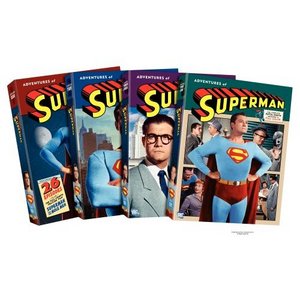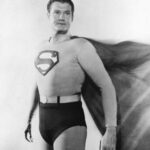Prefatory note: Shop carefully: some vendors might not sell this six-season “collection” as cheaply as the identical DVDs marketed as four, separate packages (i.e., Season One; Season Two; Seasons Three and Four; and Seasons Five and Six).
I’m not one of those diehard “Superman” freaks who can spew all the trivia you never wanted to know about Krypton, Kryptonite, George Reeves, Christopher Reeve and whatnot. I’ll leave that sort of thing to those more fanatical than I.
All I really know is that when I was a little kid in the late fifties and early sixties, The Adventures of Superman was continually rerun in gorgeous black-and-white on the little vacuum tube TV in our home. I took the show for granted back then and (seemingly) had entirely forgotten about it by the time The Beatles entered their psychedelic phase. Only when “Superman: The Movie” unexpectedly appeared in 1978 was the fun of the original series not only recaptured but, in fact, greatly surpassed. At least, that’s what I thought in 1978.
However, having recently replayed the first four (Christopher Reeve) Superman movies on DVD, and having likewise immersed myself in these early (George Reeves) episodes, I now feel even more fondness for these low-budget, exquisitely corny TV originals than for any of the relatively “modern” incarnations of the Man of Steel (albeit Superman Returns is an interesting step forward from the lesser–third and fourth–Christopher Reeve movies).
When all is said, George Reeves is the quintessential Superman because he not only does justice to the Man of Steel but also to Clark Kent, whom he portrays as a highly respectable, self-assured figure rather than the continually bumbling and all-too-vulnerable oaf of the “modern” Superman movies and shows. [This is not to say I can’t separately appreciate the enhanced “vulnerability” of the modern-day Clark Kent portrayals.] I should add that Jack Larson’s Jimmy Olsen and, especially, John Hamilton’s Perry White have never since been equaled insofar as they most aptly personify the qualities of their original DC Comics counterparts.
How can I account for my recently rekindled fondness for these borderline-mawkish TV shows of my childhood? Is it akin to my penchant for the pop music of my youth? Conceivably. Does it reflect an insidious diminution of my aesthetic sensibilities–not to mention my mental marbles? Probably.
No matter. If I’m going down, I’m going down grinning. Of late I’ve been shamelessly reveling in each episode’s opening sequence, including the increasingly thrilling words: “Faster than a speeding bullet … more powerful than a locomotive … able to leap tall buildings at a single bound” and [the part that–especially in light of subsequent history–never fails to get me gleefully smirking and slapping my knee] “… fights a never-ending battle for truth, justice, and The American Way!”
After I finish watching these George Reeves DVDs another round or two, I reckon I’ll be primed to revisit still more puerile pleasures from yesteryear. (Perhaps an “Irwin Allen in the sixties” marathon?)
Here are some of my thoughts about three prototypical episodes I unabashedly chortled over lately [not to worry, I won’t reveal the most essential plot details]:
First-season episode: “Superman on Earth”
Much like the early portions of the 1978 movie, Season One’s initial episode details how it all began back on planet Krypton and how Superbaby’s new, earthly parents adopted him. Having only recently viewed the relatively modern Christopher Reeve version, I was struck with how much of this 1952 original’s opening sequences had been reworked into the feature film. However, I was also struck by how strikingly low-tech the props seem by modern Hollywood standards. For instance, the wee rocket carrying Superbaby to earth has a door surrounded by such large, conspicuous gaps that surely even 1952 viewers scoffed.
Later, when grown-up Clark bids his Smallville phase farewell and departs for Metropolis, Mom reminds him she’d fashioned his special (red-and-blue) suit from the “indestructible” (Kryptonian) blanket in which he’d been wrapped for his original rocket journey. But, conveniently, no mention is made of how the simple lady could herself have cut that cloth!
But as the story further unfolds, I gradually find myself suspending such “grownup” disbelief and recapturing the naive delight of my early childhood.
Besides, once I hear Daily Planet editor Perry White (John Hamilton) angrily spouting off at everybody via the array of rotary-dial phones atop his desk, I begin to focus more on characterizations than plot or props. Soon the redoubtable Lois Lane (Phyllis Coates) enters with her fine face and horrible hairdo, followed by the incurably ingenuous Jimmy Olsen (Jack Larson), and, finally, mild-mannered Clark himself, who surreptitiously enters through a (conveniently open) window in order to wangle a job offer from the irascible Perry.
After a somewhat shaky start, this first installment soon reveals key elements of the reliable formula that would serve the series so well throughout its six-year run. For example, at the close a suspicious Lois testily inquires how on earth Clark had managed to beat her to the newsworthy scene and scoop her. Standing his ground, Kent innocently smiles and retorts, “Maybe I’m a superman, Miss Lane.”
Second-season episode: “Five Minutes to Doom”
This is the second season’s first episode, wherein Noel Neill capably replaces the departed Phyllis Coates as Lois Lane.
The opening scene is inside a state prison where the somber Lois and Clark visit a man slated for imminent execution. The look and feel of this scene is not unlike P.I. films of the era; clearly the writing, directing, and production are targeted to adults at least as much as children.
This episode’s scenario involves Clark’s belief in the innocence of the condemned man who must die in but a few hours. Will Kent’s doggedness and intelligence (not to mention his hidden powers) be enough to right a tragic miscarriage of justice?
Fourth-season episode: “The Wedding of Superman”
On balance, I prefer the first two seasons’ pseudo-noir episodes to (virtually) every ensuing installment. Nonetheless, what Superman fan of my generation can resist finally beholding George Reeves and gang in color? The last time some of us happened to view these episodes was via over-the-air broadcasts and smallish, black-and-white TV’s in the early to mid sixties. Being able to watch episode after episode via DVD’s and a large-screen TV is nearly akin to seeing Reeves, Neill, Larson, and Hamilton in a modern-day theatrical debut.
The color episodes admittedly comprise some notoriously silly scenarios, even including the time-traveling Clark, Lois, Jimmy and Perry in a prehistoric cave! Reportedly, back in the day there had been considerable pressure from parents and sponsors to eliminate any violence and other “adult” elements.
Against all odds, a few of the color episodes manage to rise (a bit) above such constraints and seem (at least marginally) special. One of the best examples is Season Four’s “The Wedding of Superman.
In this episode Lois falls asleep and dreams–in vivid color–that she and Superman have fallen deeply in love. After so many prior episodes where Lane and Kent were always so platonic, it’s almost awkward to see Reeves grasping Neill’s arms as she, in turn, tentatively caresses his chest. They appear on the verge of embracing. The Man of Steel duly proposes marriage, Lois accepts, and next, just as the wedding is about to be consummated,…
Well, I did promise I wouldn’t reveal all the details, didn’t I?
I’ll merely observe that–at least in a modest way–this unusual episode foreshadows the increasingly complicated relationship between Lois (Margot Kidder) and Clark (Christopher Reeve) in the 1978 and 1980 flicks.
Notes regarding the display, languages, and main menu:
As you’d expect with these vintage-TV episodes, the on-screen display is strictly full-screen. The spoken language is English and subtitles are available in English, Spanish, and French.
The “main menu” panel is nicely and colorfully rendered with sort of a classic “DC Comics” motif. Within colorfully bordered boxes are insets of video clips from various episodes. The simultaneous sound clips for those scenes are cleverly and tastefully edited.
The main-menu panel has four selectable options: “play,” “episodes,” “special features,” and “languages.” Selecting “play” initiates a marathon of all (up to six) episodes on the current disc. Selecting “episodes” calls up a list of selectable titles arranged from top to bottom (alongside a nice graphic). Selecting “special features” simply allows you to activate the “commentary” for one or two episodes on a given disc.
Special features, including selectable commentary:
A minority of the episodes in this series includes selectable commentary. The best of these feature Noel Neill and Jack Larson teaming up for some very gratifying and comfortably paced dialogue pertaining not only to the on-screen action but also sundry related anecdotes involving fellow actors, etc. I’m not always a big fan of “commentary” (for most movies), but I was very pleased to hear “Lois and Jimmy in their golden years” sounding very comfortable with their respective Adventures of Superman personas and very respectful of everybody–living or dead–involved with the original Superman series. For me the commentary is definitely an extra selling point for these delightful DVDs.
Unfortunately, the commentary is nearly all you get in the way of “special features” on most of the discs in this collection. However, there are a few very noteworthy exceptions. For example, Season One’s fifth disc includes two interesting films. One is Superman and the Mole Men, which was the 1951 “feature-film” debut of the Superman character and which starred George Reeves and Phyllis Coates and served as a pilot for the Adventures of Superman TV series. The other is the excellent, intriguing documentary “The Adventures of Superman: From Inkwell to Backlot,” which I thoroughly enjoyed. (In fact, you could do worse than to view the latter documentary before viewing anything else in this collection.)
Which episodes are color?
Beginning in 1952, the first two seasons of The Adventures of Superman were filmed in black-and-white, and the remaining four in color. In all cases I relish the abundance of vintage cars and trucks, not to mention the buildings’ interior decor. For example, the later episodes reveal Daily Planet editor Perry White’s sizable office in all its colorful, late-fifties glory, serving to rekindle some of my earliest childhood memories.
Pleasingly printed discs:
The upper surfaces of the discs are colorfully printed with photos of George Reeves (Superman/Clark Kent); Phyllis Coates (Lois Lane, season one); Noel Neill (Lois Lane, subsequent seasons); Jack Larson (Jimmy Olsen); and John Hamilton (Perry White).
Conclusion:
I can’t imagine anyone who grew up with The Adventures of Superman not strongly liking these Warner Home Video DVDs. Although it appears that Warner did relatively little–if anything–in the way of digital remastering, the video and audio quality thoroughly satisfy my (admittedly relatively undemanding) sensibilities, and the packaging and screen-menu panels are well conceived and pleasingly rendered. There could have been a bit more “special features” content, but what’s included is very good. Most owners of these “George Reeves Superman” videos will gleefully play them again and again.



